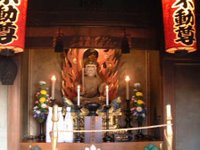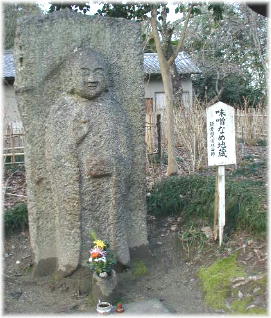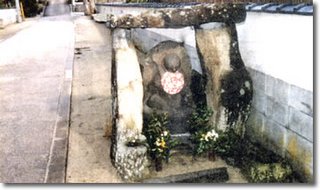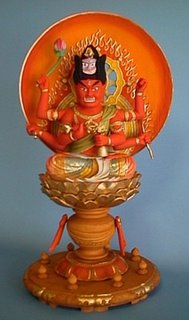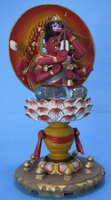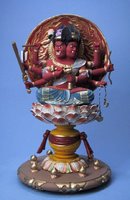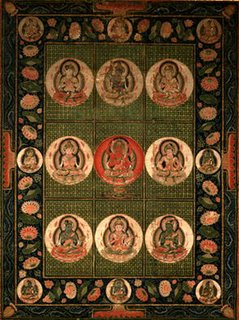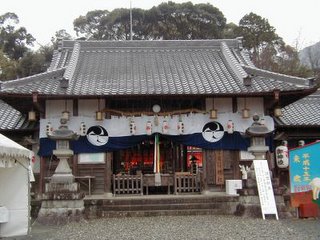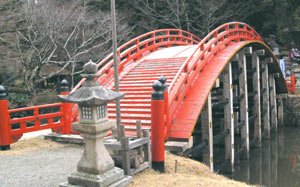nnnnnnnnnnnn TOP nnnnnnnnnnnnn
Fudo Myo-O ooooo Deutscher Text Die Schreibweise mit ô oder oo wird verwendet.
Fudoo (Acala) "Der unerschütterliche, unbewegliche Weisheitskönig". "Acala Nada" ist eine andere Bezeichnung für die hinduistische Gottheit Shiva.
Als Gesandter des Dainichi Nyorai wird er auch "Gesandter Fudô" (Fudô Shisha) oder "Ewigwährender Diamant" (Joojuu Kongoo) genannt.
Statuen des Fudoo finden sich fast nur in Japan - sehr selten in China und kaum in Indien.
Durch Kooboo Daishi Kuukai in Japan eingeführt (um 806). Seine erstmalige Beschreibung findet sich im Sutra Fukuu Kenjaku Jinpen Shingonkyoo und Dainichikyooso. Die entsprechende japanische Gottheit ist der erste Höllenkönig Shinkoooo.
Seine
Anrufung (shingon) heißt: "Nama samanda basaranan senda maka roshana sowataya untarata kanman." Dieses Heilige Mantra des Fudoo soll man drei Mal oder sieben Mal aufsagen, am besten aber 3 x 7, also 21 Mal. Dann hilft Fudoo bestimmt bei allen Problemen.
In Japan wurden die wesentlichen Merkmale des Fudoo während des 9./10. Jahrhunderts in den "Neunzehn Visualiationen" (juukukan) der beiden Priester Annen (814 - 915?) und Shunnyuu (890 - 953) kodifiziert. Ein Gläubiger konnte sich auch durch Aufschreiben von 19 Keimsilben auf verschiedene Stellen seines Körpers selbst in den Fudoo verwandeln (juuku fujikan).
Aus seinem Körper strahlen die Flammen, die alles Unwissen abtöten, daher immer mit flammendem Nimbus dargestellt. Seit dem Beginn der Heian-Zeit besonders verehrt als Schützer des Landes und seiner Einwohner. Mittelpunkt vieler magischer Feuerzeremonien (goma) des esoterischen Buddhismus.
Helfer der Berg-Asketen (shugenja), die seit der Heian-Zeit als eine Verschmelzung zwischen dem einheimischen Berggipfel-Glauben und dem Buddhismus angesehen werden können. Auch beim Gipfellaufen über 1000 Tage der Ajari-Heiligen (sennichi kaihoogyoo) im Bergtempel Hieizan, das um 900 von Soooo Sooshoo eingeführt wurde, spielt Fudoo eine wichtige Rolle. Dort zünden die Ajari jeden Tag ihre Lampe nachts an der Lampe des Fudoo Myôô an und murmeln die Anrufung des Fudoo, während sie täglich 30 bis 50 Kilometer über die Gipfel und durch die Täler laufen. Bei der Askeseübung unter einem Wasserfall wird dort die Steinstatue eines Fudô Myôô aufgestellt.
Die Berg-Asketen des Shinkooji, Tookyoo, trugen in einem hölzer~nen Schrein nur den Kopf eines Fudoo mit auf ihren Bergwande~rungen. Dieser Kopf hatte die Frisur eines Nyorai, mit vielen Wirbeln, daher auch
"Wasserschnecken-Fudoo" (Tanishi Fudoo) genannt.
In der Edo-Zeit wird Fudoo Myôô bei allen Sekten der Gegenstand besonderer Verehrung, z.B. der Narita-Fudoo. In der Stadt Edo (heute Tôkyô) selbst gab es die
fünf großen farbigen Fudoo Myôô, zur Verteidigung des Staates gegen die Feinde im Norden:
Mit schwarzen Augen (Meguro Fudoo), mit weißen Augen (Mejiro Fudoo), mit grünen Augen (Setagaya), mit roten Augen (Komagome) und mit gelben Augen (Komatsugawa): die Statuen waren gleich, aber die Farbe der Augen war verschieden. Meguro und Mejiro sind heute noch als Ortsnamen in Tookyoo erhalten. An jedem 28. eines Monats findet im Tempel des Fudoo in Meguro, Tookyoo, ein großes Fest mit Feuerzeremonien (goma kuyoo) statt, bei dem heute noch ein lebhaftes Gewimmel zu beobachten ist.
Ein eindrucksvoller
Wasserfall wird für die Gottheit Fudoo Myoooo selbst gehalten, z.B. Nachi no Taki in Kumano oder Imaizumi Fudoo in Kamakura.
Besondere Statuen werden oft in einer eigenen Halle (Myoooo Doo) innerhalb eines großen Tempelgeländes untergebracht.
Spezielle Inkarnation als "
Verkörperung des religiösen Lehrauftrags" (kyooryoo rinshin) und Bote des Dainichi Nyorai in der Mutterschoßwelt, zusammen mit Goosanze in der Diamantwelt.
Trotz furchterregendem Gesichtsausdruck eine Körperform und Haut wie ein Kind (Ausdruck der milden Gottheit bzw. Hinweis darauf, daß es sich ursprünglich um einen indischen Sklavenjungen handelte); meist sitzende Figuren (Kooboo Daishisama des Shingon). Erst später gegen Ende der Heian-Zeit als rein japanische Form stehend (Chishoo Daishisama des Tendai) mit kräftigen Muskeln dargestellt (z.B. Gelber Fudoo im Tempel Miidera).
Mittlere und größte bei fünf Statuen.
Nach Kooboo Daishi gibt es
19 Merkmale eines Fudoo, die bei Tanaka (4) ausführlich beschrieben sind.
Dickliche Kinderfigur: Es handelt sich um einen Diener des Dainichi Nyorai.
Sieben Haarknoten:
Links herabhängender Zopf: Ausdruck des allumfassenden Mitleids.
Falten auf der Stirn:
Halbgeschlossenes linkes Auge:
Oberlippe von den Zähnen eingeklemme: Mit der Kraft des Mitleids wird der Feind besiegt.
Mittlerer Teil des Mundes geschlossen:
Schwert in der rechten Hand: Tötet die drei Grundübel ab.
Seil in der linken Hand:
und so weiter
:::::::::::::::::::::::::::::::::::::::::::::::::::::::::::::::::::::::::::::::::::::::::::::::::::::Ikonografie:Ein Kopf, zwei Arme. Ganz selten mit vier Armen. Furchterregender Gesichtsausdruck mit dicken Falten auf der Stirn.
Dunkle Haut; flache Lotusblüte (chooren) auf dem Haarknoten oben auf dem Kopf (shakei motodori), Haar als Zopf über der linken Schulter (benpatsu; ursprünglich indische Dienerfigur bzw. Trägerfigur). Der Kopf bedeutet die Buddha-Welt, die linke Schulter die Menschen-Welt. Durch den verbindenden Zopf wird die Liebe der Buddhas zu allen Menschen ausgedrückt.
Manchmal sieben Haarknoten, als Ausdruck der sieben wichtigen Vorschriften und Übungen (nanamanhoo) zur Erleuchtung.
Seine Haare sind manchmal in sieben Zöpfen zusammengebunden (shichiyakei), die die sieben Stufen bei der Erlangung der Erleuchtung darstellen. (Alte Figuren des Myôô zeigen die Haarfrisur mit sieben Zöpfen, zusammengebunden mit einer Ranke (ya). Das ist die Frisur der Sklaven im alten Indien.)
Drachen-Schwert mit dreizackigem Griff oder einfaches zweischnei~diges Schwert in rechter Hand. Mit diesem Schwert kämpft er gegen die Dämonen. Seil in angewinkelter, linker Hand. Mit dem Seil rettet er die Gläubigen, indem er sie aus dem Unglück zieht.
Das Seil ist wie ein Wurfseil mit einem beschwerenden Ring an einer Seite. Mit diesem Seil bindet er auch die Feinde des Buddhismus.
Sitzt oder steht auf einem erhabenen Sockel oder einem Felssockel.
Ältere Figuren der Heian-Zeit haben beide Augen geöffnet (shoogan) und klemmen mit den oberen Eckzähnen die Unterlippe ein.
Figuren der Kamakura-Zeit haben unterschiedliche Augen: Das linke Auge fast geschlossen, nach unten zur Erde blickend; das rechte Auge weit geöffnet, nach oben zum Himmel blickend (tengan chimoku). Dabei sind die Eckzähne ebenfalls entsprechend nach oben bzw. unten gerichtet.
Der Eckzahn nach oben mahnt uns auch, daß wir uns auf dem religiösen Weg um die Erleuchtung bemühen sollen. Der Eckzahn nach unten bedeutet, daß wir uns für das Wohlergehen der Menschen unermüdlich einsetzen sollen. Der leicht geschlossene Mund mahnt uns, unnötiges Geschwätz zu unterlassen.
Meist ist sein Gesicht von blauschwarzer Farbe, der Tönung des Elementes Luft, des heiligen Zorns und der magischen Unterwerfung.
Eine besondere Form, nach der Statue im Tempel Tooji benannt, zeigen das Gesicht leicht geneigt, beide Augen nach rechts auf das erhobene Schwert blickend und trotzdem die Front beobachtend.
Bei Steinfiguren ist diese Form besonders ausgeprägt.
Flammender Nimbus, der die Kraft des Garuda-Vogels ausstrahlt, manchmal auch mit einer kleinen Vogelgestalt, besonders bei Steinfiguren.
Von acht Kindern als Gefolge umgeben, von denen zwei als besondere Begleitfiguren fast immer mit dargestellt werden. Auch von 36 Kindern oder 47 Gefolgsleuten umgeben. In neuerer Zeit finden sich Pilgerfahrten zu 36 Fudoo-Tempeln, zu jeweils einem der 36 Kinder-Figuren.
Andererseits finden sich Fudoo-Statuen als Begleitfiguren des Dainichi Nyorai, zusammen mit Goosanze, oder als Begleitfigur einer Kannon, zusammen mit Bishamonten.
Als Mittelpunkt eines Mandala kennen wir das Mandala mit Fudoo als Hauptfigur (eine Art besson mandara), das Mandala nach dem Sutra Ninnoogyoo (Ninnoogyoo mandara), das Mandala der 12 Ten (juuniten mandara) und das Mandala im Stil der Anchin-Schule (Anchin mandara).
Besondere Statuen
Fudoo-Dreiergruppe (Fudoo Sanzon) Häufig in Tempeln des Shingon-Buddhismus. Mit
Kongara dooji (Kimkara): Als Inkarnation des Fudô selbst vorgestellt. Links; lange Haare über die Schultern; milder Gesichts~ausdruck, gefaltete Hände mit einem Donnerkeil mit einem Zacken zwischen Daumen und Zeigefinger liegend oder einer Lotusblüte zwischen den gefalteten Händen. Oft von weißer Farbe.
Seitaka dooji (Cetaka): Rechts; Haare in fünf Knoten oder Zöpfen zusammengebunden. Wilder Ausdruck, Pilgerstab in rechter Hand oder Donnerkeil mit fünf Zacken. Oft von roter Farbe.
Schwert-Fudoo (Kurikara Fudoo) Kurikara FudooZweischneidiges Schwert, von einem Drachen umwickelt, der die Schwertspitze im Maul hält. Der Drachenkönig Kurika (Sanksrit: Kulikah) hat eine goldene Körperfarbe. Manchmal mit einem Horn auf dem Kopf dargestellt. Von einem flammenden Nimbus umgeben.
Nach einer Überlieferung kam es einmal zu einem Wettkampf zwischen Fudoo Myoooo und dem Vertreter einer anderen Religion. Dabei verwandelte sich Fudoo in ein flammendes Schwert, aber der Gegner tat dies ebenfalls und sie fochten ohne Ergebnis. Nun verwandelte Fudoo sich in den Drachen Kurika, umwand das Schwert des Feindes und begann, es von der Spitze her zu verschlingen. Nach dieser Geschichte entstand das Kurikara-Schwert.
Drache zunächst als Bote bzw. Symbol des Fudô und später als die Gottheit selbst verehrt. Einziges Beispiel, bei dem Symbol und Gottheit getrennt und doch als Gleichwertig verehrt werden. Für die Samurai der Edo-Zeit war das Schwert ein ganz besonderer Gegenstand der Vasallentreue; in dieser Zeit breitete sich der Kurikara Fudoo besonders aus.
Aus Holz, Bronze, Eisen oder Stein. Oft entweder in der Myôô-Halle oder davor aufgestellt.
Fudoo mit acht Kindern (Fudoo Hachidai Dooji)Die Barmherzigkeit und Milde eines Fudoo wird durch diese acht kindlichen Gefolgsleute direkt an die Menschen weitergegeben.
Eine Statue des Fudoo, umgeben von acht Kinderfiguren im Priestergewand oder in chinesischer Rüstung. Machmal acht Steinfiguren außerhalb um eine Fudoo-Halle.
Kongara und Seitaka wie bereits beschrieben. Weiterhin:
Ekoo Bosatsu (Weisheit) In der rechten Hand einen Donnerkeil mit fünf Zacken, in der linken eine Lotusblüte. Ein runder Mond-Nimbus um den ganzen Körper.
Eki Bosatsu (Freude) In der rechten Hand einen Donnerkeil mit drei Zacken oder eine Hellebarde mit drei Zacken, in der linken das wunscherfüllende Juwel.
Anogudatsu (Anokuta) Bosatsu (Reinheit) Auf dem Kopf den Vogel Garuda; in der rechten Hand einen Donnerkeil mit einer Zacke, in der linken eine Lotusblüte; sitzt auf einem grünen Drachen.
Shitoku Bosatsu Trägt eine chinesische Rüstung. In der rechten Hand einen Donnerkeil oder das Rad der Lehre, in der linken einen Dreizack.
Ukubaka Bosatsu In der rechten Hand ein Schwert, in der linken einen Donnerkeil mit drei Zacken, an die Brust gedrückt.
Shoojoo Biku Kahlgeschorener Kopf, Gestalt eines buddhistischen Priesters (biku), mit Schärpe über der linken Schulter. Die rechte Hand mit einem Donnerkeil mit drei Zacken auf die Brust gelegt, in der linken eine Sutrarolle oder Sutraschatulle.
Fudoo mit 36 Kindern (Fudoo Sanjuuroku Dooji) Eine Statue des Fudoo, umgeben von 36 Kinderfiguren im Priestergewand oder in chinesischer Rüstung. Machmal 36 Steinfiguren außerhalb um eine Fudoo-Halle. Unterschiedliche Kleidung und verschiedene Gegenstände in den Händen.
Nach dieser Formation entstand in neuester Zeit eine Pilgerfahrt zu 36 Fudoo-Tempeln, zu jeweils einem dieser Kinder.
Fudôe, Kômôshô, Mukukô, Chietô, Shôseikô, Fushigi, Shishikô, Shishie, Hôkyôgo, Daikômyô, Chuukômyô, Butsushuugo, Hôshugo, Sôshugo, Kongôgo, Kokuugo, Kokuuzô, Hôsôgo, Kichijômyô, Kaikôe, Myôkuuzô, Fukôô u.a.
Wellenzerschneidender Fudoo (Namikiri Fudoo)Namikiri FudooStatue im Westlichen Tempel (Nan-In) des Tempelberges Kooyasan.
Kooboo Daishi stellte diese Statue während seinem Aufenthalt in China selbst her. Auf der Rückreise nach Japan geriet das Schiff in einen starken Sturm. Da beschwor Kooboo Daishi die Statue, allen zu helfen und siehe da, Fudoo zog sein Schwert, zerschnitt die Wellen und brachte das Unwetter zur Ruhe.
Diese Statue hat als Besonderheit eine Haarfrisur, bei der die Haare in kleinen Schatz-Knoten (gyokukei) aufgebunden sind. Ansonsten entspricht sie den 19 Vorschriften des Kooboo Daishi. Die Statue steht auf einem Sockel, der wilde Wellen darstellt.
Im Tempel Dainichiboo am Yuudono-Berg gibt es einen Wellenzerschneidenden Fudoo, bei dem Fudoo selbst sich nach vorne beugt und das Schwert im Mund hält.
Fünf Große Myoooo (Godai Myoooo)Gruppierung des esoterischen Buddhismus, die wahrscheinlich nicht in Indien, sondern in China entstanden ist. Zur Vertreibung eines persönlichen Feindes als politisches Werkzeug eingesetzt, mit speziellen Feuerzeremonien, z.B. Zwist zwischen Genji und Heike (Godan no hoo = fünf Priester beten gleichzeitig zu je einem Myoooo).
Heute noch wird im Tempel Tooji in Nara eine siebentägige Neujahrszeremonie mit Gebeten für das Wohlergehen des Tennoo-Hauses, den Schutz des Landes und eine gute Ernte abgehalten (Goshichinichi no mishiho), bei dem die fünf Myoooo im Mittelpunkt der Verehrung stehen. Es handelt sich dabei um die ältesten Myoooo-Statuen in Japan, die nach den Anweisungen von Kooboo Daishi geschaffen wurden. Vor der Meiji-Restauration wurde diese Zeremonie jährlich im Tennoo-Palast abgehalten.
Entsprechend den fünf Weisheitsbuddhas der Diamantwelt:
Fudoo (Mitte; Dainichi Nyorai), Goosanze (Osten; Ashuku Nyorai), Gundari (Süden; Hooshoo Nyorai), Daiitoku (Westen; Amida Nyorai) und Kongoo Yasha (Norden; Fukuu Jooju Nyorai). In der Tendai-Sekte anstelle des Kongoo Yasha der Uzusama Myoooo. Diese Kombination entstand in China während der T'ang-Zeit, nicht in Indien. Nach anderen Schriften wurde sie erst in Japan begründet. Auch die Diamant-Glocke mit den fünf Myoooo (Godai Myoooo Rei) findet sich nur in Japan.
Bei diesen fünf Myoooo handelt es sich um die furchterregenden Inkarnationen (kyooryoo rinshin) der fünf Nyorai. Sie vertreiben gemeinsam das Unheil aus allen Richtungen. Ihre Vorform sind die
Fünf Bosatsu Gewaltiger Kraft (Godairiki Bosatsu).
Fünf Bildrollen mit den fünf Gottheiten werden "Godaizon" genannt.
Auch als acht Figuren (hachidaison) verehrt. Das sind die fünf großen Myoooo und dazu Munooshoo, Dairin und Buchaku Myoooo. Manchmal wird auch der Pferdeköpfige Myoooo dazugezählt.
In der Mitte Fudoo, darum die anderen Myoooo. Alle mit mehreren Armen und mit flammendem Nimbus.
Manchmal sitzt Fudoo in der Mitte auf einem Wasserbüffel.
Goosanze mit vier oder drei Köpfen, mit acht Armen, steht auf einer liegenden Frauen- und einer Männerfigur.
Daiitoku mit sechs Köpfen, sechs Armen und sechs Beinen, manchmal auf einem Wasserbüffel.
:::::::::::::::::::::::::::::::::::::::::::::::::::::::::::::::::::::::::::::::::::::::::::::::::::::
Zitiert aus meinem Buch
Buddhastatuen (Buddhastatues) Who is Who,
Ein Wegweiser zur Ikonografie von japanischen Buddhastatuen
by Gabi Greve:::::::::::::::::::::::::::::::::::::::::::::::::::::::::::::::::::::::::::::::::::::::::::::::::::::
Alphabetical Index of the Daruma Museum
